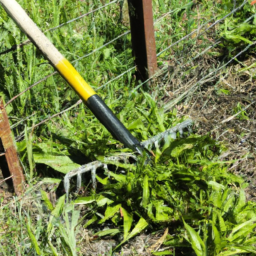How To Clear A Vegetable Garden Full Of Weeds
How To Clear A Vegetable Garden Full Of Weeds
How To Clear A Vegetable Garden Full Of Weeds
Features
Weeds can take away valuable resources such as fertility and sunlight from vegetable gardens. As such, it is important to protect your vegetable garden from infestation with weeds. Some common weed control concepts include hand-weeding, mulching, using herbicides, and maintaining regular mowing and cultivation. This article will explore all of these features in detail and discuss how to incorporate them into a weed-free vegetable garden.
Hand-Weeding
Hand-weeding involves manually removing weeds from the vegetable garden by either using a small hand-hoe or traditional hoe. The absolute best way to control weeds is to remove them from the root, which requires digging into the soil around the weed. Hand-weeding is a great way to get rid of hard-to-reach weeds. This method is especially useful for those wishing to avoid the use of herbicides.
Mulching
Mulching is a technique used to prevent weeds from germinating and growing in the vegetable garden. Different types of mulches can be used, such as organic materials like dried leaves, straw, wood chips, or plastic sheeting. Mulching smothers the weeds by blocking sunlight and trapping moisture in the soil.
Herbicides
Herbicides are chemical compounds used to kill weeds. There are a variety of herbicides available, but it is important to read the labels carefully to make sure they are safe for use around edible plants. It is best to use herbicides as a last resort, as they can be damaging to beneficial insects and other organisms in the vegetable garden.
Mowing and Cultivation
Mowing and cultivation can also help reduce the number of weeds in the garden. Regularly mowing the edges of the garden and cultivating the soil helps reduce weed pressure. This also serves to aerate the soil, allowing water and oxygen to reach the roots of the vegetable plants.
Benefits
A well-kept vegetable garden can provide many benefits. A weed-free garden allows for maximum growth of the vegetables and allows the vegetables to soak up the sun and nutrients they need. Furthermore, a healthy vegetable garden requires less effort and attention from the gardener, as they will not need to spend time and energy weeding. As such, a well-maintained vegetable garden can minimize the amount of time needed for maintenance and care.
Pros and Cons
Each of the methods discussed in the Features section carries its own advantages and disadvantages. Hand-weeding is a labor-intensive method, but it removes the weed from the root and does not introduce any chemical compounds into the environment. Mulching is a great way to control weeds, but mulches can sometimes be expensive. Herbicides are effective, but they can damage the soil if not used carefully. Mowing and cultivation can help keep weeds under control, but they may not be an effective solution for heavily weeded gardens.
Case Studies
Weed Management in a Home Garden
A home garden in Baltimore County, Maryland sought to reduce the weeding burden for the gardeners. The gardeners implemented a weed management program that included hand-weeding, mulching, and the use of a herbicide when necessary. After one season, the vegetable garden was well on its way to being weed-free.
Organic Vegetable Garden in a School Garden
A school garden in Minneapolis sought to convert to an organic vegetable garden. The gardeners incorporated weed control strategies such as hand-weeding and mulching to ensure minimal exposure to chemicals. After two years, the garden was weed-free and the vegetables were producing a good harvest.
Frequently Asked Questions
What is the best way to control weeds?
The best way to control weeds is to use a combination of different techniques. Hand-weeding, mulching, using herbicides, and cultivation are all effective methods of weed control. It is important to read the labels of any herbicides carefully to make sure they are safe for use around edible plants.
Can mulching be used to control weeds?
Yes, mulching can be an effective way to control weeds. Different types of mulches can be used, such as dried leaves, straw, wood chips, or plastic sheeting. Mulching smothers the weeds by blocking sunlight and trapping moisture in the soil.
Mistakes People Make
One of the most common mistakes made when trying to control weeds is using too much herbicide. It is important to read the labels carefully and use only the recommended amount of herbicide. Too much herbicide can damage the soil, harm beneficial insects, and result in poor yields. It is also important to be careful when using hand-weeding and cultivation, as too much of these activities can damage the root systems of established vegetables.
Best Practices
The best way to control weeds is to use a combination of hand-weeding, mulching, herbicides, and regular mowing and cultivation. It is important to read the labels of any herbicides carefully to make sure they are safe for use around edible plants, and to use only the recommended amount. Additionally, it is important to be gentle when weeding by hand and cultivating, to avoid damaging the root systems of established vegetables.
Conclusion
Weeds can be damaging to vegetable gardens, as they take away resources such as fertility and sunlight. However, with the right strategies, a vegetable garden can be kept weed-free and healthy. This article has explored different features, benefits, pros and cons, case studies, FAQs, mistakes people make, and best practices for controlling weeds in vegetable gardens. By implementing a combination of strategies, gardeners can enjoy a healthy, weed-free vegetable garden.

Previous Page
